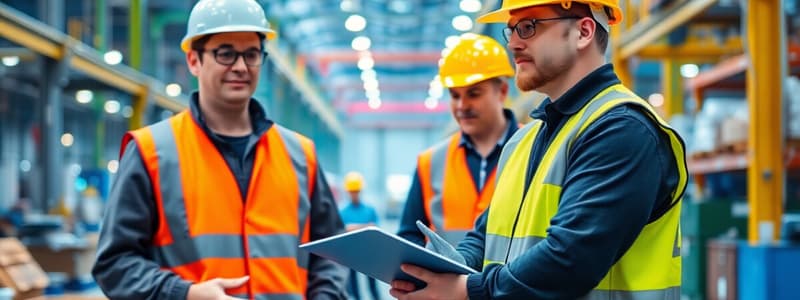Podcast
Questions and Answers
What is one effective way for factories to automate hazardous tasks?
What is one effective way for factories to automate hazardous tasks?
- Use robotics or AI systems for hazardous tasks (correct)
- Implement manual labor for all tasks
- Limit worker access to computer-operated machinery
- Increase the number of employees handling dangerous tasks
What is one challenge associated with retrofitting older factories to meet modern safety standards?
What is one challenge associated with retrofitting older factories to meet modern safety standards?
- Modern safety standards are less strict than older ones
- Costly retrofits may be required for safety enhancements (correct)
- Older factories are often built with advanced technology
- Newly built factories require more safety measures
How can air quality in a factory be monitored effectively?
How can air quality in a factory be monitored effectively?
- Installing sensors that measure CO2 and other pollutants (correct)
- By observing worker behavior and complaints
- Only during scheduled maintenance checks
- By using manual checks once a month
What is an important ergonomic consideration for factory workstations?
What is an important ergonomic consideration for factory workstations?
What should be the target range for lighting levels in factories to support general tasks?
What should be the target range for lighting levels in factories to support general tasks?
What is the acceptable noise level in a factory setting to avoid hearing loss?
What is the acceptable noise level in a factory setting to avoid hearing loss?
What is the recommended temperature range for comfortable working conditions in factories?
What is the recommended temperature range for comfortable working conditions in factories?
What is the main purpose of proper ventilation in a factory?
What is the main purpose of proper ventilation in a factory?
Which lighting level is recommended for precision tasks in a factory?
Which lighting level is recommended for precision tasks in a factory?
Why should factory layouts consider ergonomic principles?
Why should factory layouts consider ergonomic principles?
What are acceptable CO2 levels in a factory to ensure good air quality?
What are acceptable CO2 levels in a factory to ensure good air quality?
What is a potential risk of high humidity in factories?
What is a potential risk of high humidity in factories?
What should be done to prevent slips and falls in a factory?
What should be done to prevent slips and falls in a factory?
What maximum repetitions per minute is recommended for hand-intensive work to limit repetitive tasks?
What maximum repetitions per minute is recommended for hand-intensive work to limit repetitive tasks?
What is the maximum allowable concentration of carbon monoxide in a factory environment?
What is the maximum allowable concentration of carbon monoxide in a factory environment?
Which type of lighting is recommended for fine detail tasks in a factory?
Which type of lighting is recommended for fine detail tasks in a factory?
What noise level compliance is required for an 8-hour shift to prevent hearing damage?
What noise level compliance is required for an 8-hour shift to prevent hearing damage?
What is the minimum width required for emergency exit doors in a factory?
What is the minimum width required for emergency exit doors in a factory?
What is the ideal evacuation time for large factory facilities?
What is the ideal evacuation time for large factory facilities?
How should the work surface be positioned for standing tasks to ensure ergonomic safety?
How should the work surface be positioned for standing tasks to ensure ergonomic safety?
What potential consequence can occur from ignoring safety factors in a factory?
What potential consequence can occur from ignoring safety factors in a factory?
Flashcards
What lux levels are needed for general and precise tasks?
What lux levels are needed for general and precise tasks?
Lighting levels in a factory should be between 300-500 lux for general tasks and up to 1000 lux for precise tasks.
What are the recommended noise levels for factory work?
What are the recommended noise levels for factory work?
Noise levels in a factory should be below 85 dB for an 8-hour workday. Noise above 100 dB should be limited to 15 minutes per day without hearing protection.
Why is ventilation important in factories?
Why is ventilation important in factories?
Proper ventilation in factories removes harmful contaminants from the air, keeping them below the Threshold Limit Values (TLVs) set by health organizations.
What is considered adequate air exchange in a factory?
What is considered adequate air exchange in a factory?
Signup and view all the flashcards
What is the ideal temperature range for factory work?
What is the ideal temperature range for factory work?
Signup and view all the flashcards
How does humidity impact worker safety and performance?
How does humidity impact worker safety and performance?
Signup and view all the flashcards
What are common safety hazards in factories and how can they be addressed?
What are common safety hazards in factories and how can they be addressed?
Signup and view all the flashcards
Why is ergonomic design important in factories?
Why is ergonomic design important in factories?
Signup and view all the flashcards
Automation for safety
Automation for safety
Signup and view all the flashcards
Training for safety
Training for safety
Signup and view all the flashcards
Safety in old factories
Safety in old factories
Signup and view all the flashcards
Safety in new factories
Safety in new factories
Signup and view all the flashcards
Technology and safety
Technology and safety
Signup and view all the flashcards
Ergonomic Workstation Design
Ergonomic Workstation Design
Signup and view all the flashcards
Mitigating Air Quality Issues
Mitigating Air Quality Issues
Signup and view all the flashcards
Improving Factory Lighting
Improving Factory Lighting
Signup and view all the flashcards
Managing Noise Levels
Managing Noise Levels
Signup and view all the flashcards
Emergency Evacuation Plan
Emergency Evacuation Plan
Signup and view all the flashcards
Ergonomic Safety Assessment
Ergonomic Safety Assessment
Signup and view all the flashcards
Consequences of Neglecting Safety
Consequences of Neglecting Safety
Signup and view all the flashcards
Ergonomics
Ergonomics
Signup and view all the flashcards
Study Notes
- No information provided to generate study notes. Please provide text or questions.
Studying That Suits You
Use AI to generate personalized quizzes and flashcards to suit your learning preferences.




